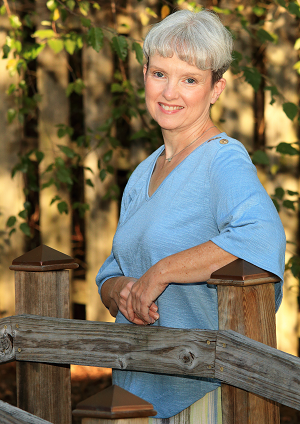
Sonja Beach visited Duke Eye Center for a consultation as a last resort in September 2020 after having almost unbearable pain and light sensitivity in her right eye after being treated for an eye infection by her primary care provider. She was familiar with the symptoms, because in 2010 she had an intracorneal ring segment (ICRS) removed from her left eye due to the similar discomfort. This time it was different though, there was a lot more pain, and she was experiencing severe light sensitively.
Beach initially elected to have bilateral ICRS implants in 2000 to help her nearsightedness, just as the technology was beginning to emerge.
Upon her initial visit at Duke Eye Center, she was told that the implant would need to be removed – holes had developed in her cornea, which were the cause of the pain and light sensitivity she was feeling.
 “My first thought was, I’m going to go blind,” Beach remembers thinking after hearing the news. She was assured that she would not go blind but may have some permanent damage to her eye, and was referred to Duke corneal surgeon Lloyd Williams, MD, PhD for a consultation.
“My first thought was, I’m going to go blind,” Beach remembers thinking after hearing the news. She was assured that she would not go blind but may have some permanent damage to her eye, and was referred to Duke corneal surgeon Lloyd Williams, MD, PhD for a consultation.
The next day, Beach was surprised to hear from Williams’ scheduler Tina Mazzurco, COT who happened to review her chart that morning and noticed that her case was severe, and that she needed to come as soon as possible for the ICRS removal.
Beach returned to Duke for surgery two days later and felt instant relief after the procedure. “I just cried because I was just so relieved,” she said.
Problems with ICRS do not happen frequently and removal is not typically revolutionary or surprising. “Ms. Beach is the only patient I have ever seen with a significant problem from INTACS. What stood out immediately upon seeing her is the deep hole in her cornea extending all the way down to the INTACS. It is very uncommon to see so deep a lesion without infection or severe inflammatory disease,” said Williams.
Following the procedure at Duke, it appeared that she was making good progress and her eye was healing until she felt the same pain and irritation again.
Williams discovered that Beach’s eye had epithelial ingrowth into the channel where the ICRS had been located after removing it. The ingrowth was causing pain, decreased vision, and inflammation with some new corneal melting. He had never seen a case like this before, so he did some research before approaching treatment. “We spent some time looking for papers or reports on how other ophthalmologists did this and didn't find anything, so we had to figure it out using surgical and engineering principles,” said Williams.
Williams decided to treat the epithelial ingrowth into the channel by performing a washout of the channel with saline. He made a cut down at both ends and flushed the channel from one end to the other and then sutured the floor of the channel to the roof of the channel while at the same time closing the incisions. After several schematics Williams and his team came up with a good drawing of how the mechanics of the situation worked and how exactly to perform the procedure without creating any new problems or decreasing her vision.
That part of the journey was the part that was so unique because a case like this had not been documented anywhere. “That's where his pioneering mindset and his ability to think through and solve a problem that had never been solved came into play,” Beach said of Dr. Williams’s treatment.
It was only later that Beach learned she had been potentially days away from losing her sight.
Williams has experienced nearly losing his vision. “I found that I felt like I was losing more than just sight, I was losing who I was. Although all people are different, I have always assumed that patients have a similar anxiety about losing vision. Overall, I think my own experiences have added empathy to how I view patients,” said Williams.
Thanks to Williams’ pioneering intervention, Beach’s irritation is gone, and her vision is better than ever. “I can see better now than I've ever seen,” she says. “I don’t even need reading glasses anymore.”